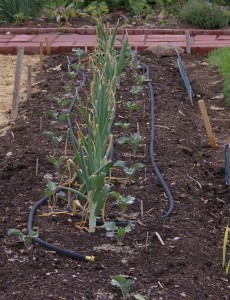
Fall clean up time is a good time to make notes on how your interplanting choices worked. There are some basics that help with planning in the spring, but results are also going to be affected by thinks such as:
- a specific variety of vegetable,
- exposure of a particular bed,
- the weather in any given year, and,
- ahem, your spatial reasoning skills.
In the spring, you will want to think about:
Plant Shapes – Where is the bulk of the plant going to grow and expand? Above ground or underground? Upright or vining?
Light Requirements – Will a plant benefit from, or be stunted due to, shade after companion plants have gotten larger?
Water Needs – Will extra foliage around help mulch, therefore retaining needed water? Or will it stimulate premature rotting? Do the plants have similar enough water needs, in amount and method of delivery?
Inhibiting Factors – Are you increasing risk of crop failure by planting things together that share disease or insect susceptibility? Do you know which plants send out chemical signals that suppress other plants?
Support Needs – Will one kind of plant tend to climb another graciously or smoother it? Can one of the plants actually provide structure?
Most plants look so small in the spring. In the fall, you can take note of how much space they fill when full grown. The advantages of space efficiency are lost if one plant chokes out another. Here is how a few things worked for me this year.


Although this combination has worked well for me in the past, this year the broccoli was too close to the onions. Even though the onions started out much larger than the broccoli, this variety of broccoli is a larger, late season variety than some I have grown. It is hard to find any of the onions![hr]

The carrots were well under the skirts of the Stupice tomatoes, but apparently got enough sunlight for a decent yield.

[hr]
The cucumbers were supposed to get trained up the trellis, but one day I looked and they were hugging the bell peppers! The peppers were okay with that.


[hr]
The cantaloupe were … actually pumpkins…. Some days, as you carry a seed packet to the garden, the seed turns to a different kind in your head, even if you mechanically label the row correctly. SO, the cantaloupe vines that were supposed to grow lower to the ground near the pole beans, were actually pumpkin plants with baby-elephant-ear leaves reaching up to my thighs. Since they were only on one side of the beans, it was manageable and both produced abundantly. 🙂

The lettuce in the spring was too overbearing for the garlic planted in the same row the previous fall. However, the garlic made a comeback this fall and was transplanted next to the other bulbs recently planted.


And lastly, my leeks and potatoes got on rather well. The leeks were on the outside edges (as opposed to the previously mentioned onions and garlic), so that may have helped. When the potato plants died back the leeks were very vigorous.[hr]
I have an older edition of the book Carrots Love Tomatoes: Secrets of Companion Planting for Successful Gardening that I have paged through many times for ideas of companion or interplanting. I like the look of the garden with the plants kind of cozy, as much as I like the practical benefits. If only my spatial reasoning could be more in tune with reality and my memory lasted longer than 50 feet. Even with these personal limitations, quite a few things in my garden grow. I am grateful.
